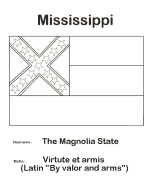




|
 |
 |
| |
State of Mississippi Coloring Page Sheets
The 50 States coloring pages
|
|
Mississippi coloring pages are a fun way to teach Pre-K through 3rd grade students history, geography and demographics,
and for elementary students to learn about their own (and other) states.
|
| LIST of States |
|


|


AL - Mississippi
Mississippi Postage Stamp Coloring Page - USPS State Stamp
Mississippi State Quarter Coloring Page - 50 State Quarter
Mississippi State Flag Coloring Page - State Flag to Color
Mississippi Map 1 Coloring Page - State Demographic Map to Color
Mississippi Map 2 Coloring Page - Easy State Shape Outline Map
|
Before the Civil War, Mississippi was the fifth-wealthiest state in the nation, wealth generated by cotton plantations along the rivers.
Slaves were then counted as property and the rise in the cotton markets since the 1840s had increased their value. A majority - 55 percent -
of the population of Mississippi was enslaved in 1860. Ninety percent of the Delta bottomlands were undeveloped and the state had low
population overall.
Largely due to the domination of the plantation economy, focused on the production of agricultural cotton, the state was slow to use its
wealth to invest in infrastructure such as public schools, roads and railroads. Industrialization did not come in many areas until the late
20th century. The planter aristocracy, the elite of antebellum Mississippi, kept the tax structure low for themselves and made private
improvements. Before the war the most successful planters, such as Confederate President Jefferson Davis, owned riverside properties along
the Mississippi River. Most of the state was undeveloped frontier away from the riverfronts.
During the Civil War, 30,000 mostly white Mississippi men died from wounds and disease, and many more were left crippled and wounded.
Changes to the labor structure and an agricultural depression throughout the South caused severe losses in wealth. In 1860 assessed valuation
of property in Mississippi had been more than $500 million, of which $218 million (43 percent) was estimated as the value of slaves. By 1870,
total assets had decreased in value to roughly $177 million.
Poor whites and landless former slaves suffered the most from the postwar economic depression. The constitutional convention of early 1868
appointed a committee to recommend what was needed for relief of the state and its citizens. The committee found severe destitution among
the laboring classes. It took years for the state to rebuild levees damaged in battles. The upset of the commodity system impoverished
the state after the war. By 1868 an increased cotton crop began to show possibilities for free labor in the state, but the crop of 565,000
bales produced in 1870 was still less than half of prewar figures.
Blacks sold timber and developed bottomland to achieve ownership. In 1900, two-thirds of farm owners in Mississippi were blacks, a major
achievement for them and their families. Due to the poor economy, low cotton prices and difficulty of getting credit, many of these farmers
could not make it through the extended financial difficulties. Two decades later, the majority of African Americans were sharecroppers.
The low prices of cotton into the 1890s meant that more than a generation of African Americans lost the result of their labor when they
had to sell their farms to pay off accumulated debts.
Blacks sold timber and developed bottomland to achieve ownership. In 1900, two-thirds of farm owners in Mississippi were blacks, a major
achievement for them and their families. Due to the poor economy, low cotton prices and difficulty of getting credit, many of these farmers
could not make it through the extended financial difficulties. Two decades later, the majority of African Americans were sharecroppers.
The low prices of cotton into the 1890s meant that more than a generation of African Americans lost the result of their labor when they had
to sell their farms to pay off accumulated debts.
Mississippi's rank as one of the poorest states is related to its dependence on cotton agriculture before and after the Civil War, late
development of its frontier bottomlands in the Mississippi Delta, repeated natural disasters of flooding in the late 19th and early 20th
century requiring massive capital investment in levees, heavy capital investment to ditch and drain the bottomlands, and slow development
of railroads to link bottomland towns and river cities. In addition, when conservative white Democrats regained control, they passed the
1890 constitution that discouraged industry, a legacy that would slow the state's progress for years.
Please note, we gladly accept submissions from state and local government agencies and departments (Department(s) of tourism, agriculture, etc.)
for display of additional state coloring pages on our site. In addition we accept submissions from established and recognized industries, or local
places of interest (cities, parks, attractions) that may make available quality content that is specific to a particular state. Contact us if
you have the capability and authority to provide such content, we would be happy to promote your state, city, attraction, event, etc.!
*** State information courtesy of Wikipedia ***
|
|
|
|
 |
|


|

